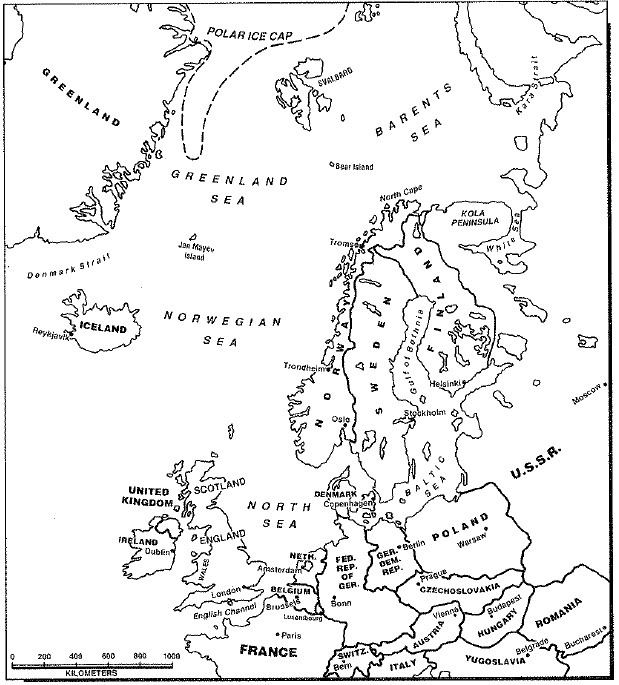 | ||
Exercise Mainbrace was the first large-scale naval exercise undertaken by the newly established Allied Command Atlantic (ACLANT), one of the two principal military commands of the North Atlantic Treaty Organization (NATO). It was part of a series of NATO exercises jointly commanded by Supreme Allied Commander Atlantic Admiral Lynde D. McCormick, USN, and Supreme Allied Commander Europe General Matthew B. Ridgeway, U.S. Army, during the Fall of 1952.
Contents
Naval activities in north Atlantic, 1946-1951
The strategic importance of control of Norway and the adjacent Norwegian and Barents seas was recognized by Anglo-American naval planners as early as the First World War. The invasion and Occupation of Norway by Nazi Germany during World War II confirmed the importance of the region, as Germany was able to establish bases for submarine and air operations against Allied convoys bound for the Soviet seaport of Murmansk.
Following the Second World War, several former allied navies executed a number of individual and multinational exercises, including:
Operational history
Initial planning for Exercise Mainbrace was initiated by General Dwight D. Eisenhower prior to his resignation as NATO's Supreme Allied Commander Europe (SACEUR) to run for the President of the United States. The exercise itself was commanded jointly by SACLANT Admiral Lynde D. McCormick, USN, and SACEUR General Matthew B. Ridgeway, U.S. Army, with the immediate theater commander being Admiral Sir Patrick Brind, RN, who was in Commander-in-Chief Allied Forces Northern Europe.
Mainbrace was conducted over twelve days between September 14–25, 1952, and involved nine navies: United States Navy, the British Royal Navy, French Navy, Royal Canadian Navy, Royal Danish Navy, Royal Norwegian Navy, Portuguese Navy, Royal Netherlands Navy, and Belgian Naval Force operating in the Norwegian Sea, the Barents Sea, the North Sea near the Jutland Peninsula, and the Baltic Sea. Its objective was to convince Denmark and Norway that those nations could be defended against attack from the Soviet Union. The exercise featured simulated carrier air strikes against "enemy" formation attacking NATO's northern flank near Bodø, Norway, naval air attacks against aggressors near the Kiel Canal, anti-submarine and anti-ship operations, and U.S. marines landing in Denmark.
Force composition
Eighty thousand men, over 200 ships, and 1,000 aircraft participated in the Mainbrace. The New York Times' military reporter Hanson W. Baldwin described this NATO naval force as being the "largest and most powerful fleet that has cruised in the North Sea since World War I."
USS Franklin D. Roosevelt with Carrier Air Group 17 (CVG-17):
USS Midway with Carrier Air Group 6 (CVG-6):
USS Wasp and Carrier Air Group 1 (CVG-1):
HMS Eagle:
HMS Illustrious:
Other NATO Military Exercises - Fall 1952
Exercise Mainbrace was part of a series of NATO exercise jointly commanded by Admiral McCormick and General Ridgeway during the Fall of 1952 involving 300,000 military personnel engaged in maneuvers from the Arctic Circle to the Mediterranean Sea.
Two exercises were conducted by NATO's Allied Forces Southern Europe during the Fall of 1952. Ancient Wall was a series of military maneuvers involving ground small unit tactical training, land-based tactical air support, and carrier-based air support. Longstep was a ten-day naval exercise held in the Mediterranean Sea during November 1952 involving over 170 warships and 700 aircraft under the overall command of Admiral Carney. The objective of the Allied ("Blue") forces was to dislodge enemy ("Green") invasion forces from their occupying positions in the Eastern Mediterranean. Blue naval forces were centered around the U.S. Sixth Fleet, under the command of Vice Admiral John H. Cassady, USN, and its two aircraft carriers, the Franklin D. Roosevelt and Wasp. Green forces included submarines and land-based aircraft. The exercise concluded with an amphibious landing at Lebidos Bay south of İzmir, involving 3000 French, Italian, and Greek troops, including the Battalion Landing Team 3/2, under the overall command of General Robert E. Hogaboom, USMC.
Aftermath
The Soviet Union characterized Mainbrace, Holdfast, and other NATO military exercises as "war-like acts" by NATO, with particular reference to the participation of Norway and Denmark, while the USSR was preparing for its own military maneuvers in the Soviet Zone.
